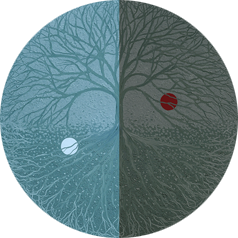
Theme by Kota Neelima
Metaphors of the Moon
Theme
The absence, like the presence, is a much-misunderstood notion. The absence of pain is not happiness, the absence of faith is not treachery, the absence of difference is not uniformity, and the absence of isolation is not togetherness. The absence represents reconciliation in a world torn apart by loss, defeat, desperation and death. The humankind, born and bred on poverty and deprivation, learns to reconcile to the absence, and rationalize the presence.
The absence is never inert. It interacts with the mind, in the same way as the absence of the Moon leaves the sky open for reinterpretations. The absence is never homogenous. It is not sameness; like the changing Moon, it is textured with all that which could have been and all that which still can be. The absence is never the opposite of the presence, in the same way as the half Moon is not half, but always complete. The absence is the Unmanifest; it is the original state of the Creation and the mind recognises that. This may be the reason why reconciliation is intuitive and inevitable in human life.
If such a void is the original state of the mind, it seeks to return to it as often and as permanently as possible, through the cycle of creation, immersion and regeneration. The creation is caused by stimuli for thought that have the power to replace the absence with presence. The Unmanifest is manifest because of the mind. It is, after all, the same Moon, the same eyes. But the mind that perceives it has changed, and in its endless changing, sees the Moon as a stranger would. This immersion of the mind in thought endows it with the power to create. It also leaves an absence in the mind once the creation is formalised and returns the mind to a state of void.
The regeneration of the mind takes place with the shared experience of the world. The mind has never been individual, it has always been collective. The universal mind, which travels to the stars and back in a moment, can also feel every beating heart of humanity, every cry of pain, and every tear of happiness. In this regeneration of the mind, there is freedom; there can be no restrictions on which influences are to be chosen and which are not. The mind, like the Moon, attracts that light which it wants to reflect. And thus, creates new thought, new action in a cyclic repetition of absence and presence.
In the deeper realm, where the mind allows itself to be boundless, it solves the mysteries of its origin and progress. Its singularity allows it to reconcile to the absence without the help of the Manifest world with its pleasure and pain, loss and gain. With the help of the Manifest world, however, such reconciliation is never complete. The (un)reconciled will defy any normative resolution because the Manifest is a perception, an interpretation, a fable. The Manifest seeks reconciliation and is disappointed when it fails to find it. With the Unmanifest, there is no need for reconciliation, and there is no (un)reconciled. For this reason, the mind locates the absence at the heart of every presence; the (un)reconciled at the back of every reconciliation. No life is reconciled, no peace permanent. This is a world built on belief in the imagination of the human mind; it is neither final nor true. It is, however, universal.
The 2018 series of paintings, Metaphors of the Moon, charts the trajectories of the mind as it travels from absence to presence in an eternal cycle. The mind is the metaphor for the Moon. It represents the cyclic process of thought; its creation, immersion and regeneration, and also is a metaphor for absence and presence. The lessons of the Moon are about the fragility of reconciliation and the assurance of restoration. The paintings are this visualization of the individualized collective mind that embraces the one and the infinite with the same ease as it deals with universal pain, suffering and loss. The mind engages with natural ease with the task of the larger and impersonal, rather than the smaller and personal.
Like the Moon, the mind too reduces itself to fit the mortal world. It binds itself to the temporal, despite the knowledge of its timelessness, and expanse. The paintings in the present series seek to depict this universal mind that encompasses time and space, and comprehends past and future. They envisage the consciousness as the tree whose roots seek its origin, to be found at a distance from its material branches. The 25 works in the 2018 series represent the various metaphors of the Moon, from the waters of creation to the transcendent imaginations of future. The gods were created by the human mind that knows of the Unmanifest; like the Moon, it is the same that is different, it is a metaphor of the mind.
